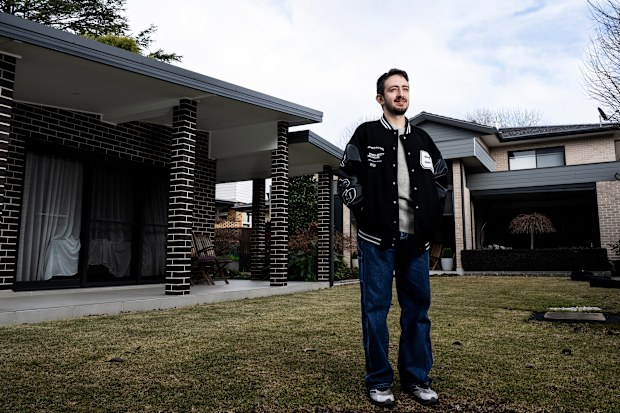These days, building a granny flat could pay off big time
A granny flat used to be a term for the small backyard home built for ageing family members, but amid a housing affordability crisis, younger generations are changing its meaning as they move in instead.
Anthony Di Marino, 25, and his girlfriend Maddy Calderon, 26, moved into a granny flat at the back of Di Marino’s parents’ house at Normanhurst in Sydney’s north so they can save up for a house.

Anthony Di Marino in the backyard between the granny flat and his parent’s house in Normanhurst. Louise Kennerley
The couple was paying $560 a week, plus utilities, for an old unit nearby that was roughly the same size as the granny flat, but they’re now saving that cash for a deposit by living in the backyard home for free.
“[Moving into the granny flat] allows us to plan for the future. Before we were living just to get through the week, not in an awful way where we were living pay cheque to pay cheque, but we had never been able to plan ahead,” Di Marino said.
The couple is planning to get married and potentially have a baby while living in the two-bedroom, 60-square-metre flat. They’re aiming to save a house deposit and move out in about three years.
“We do want to buy local, but obviously that is going to be quite the challenge. So we have a bit of a plan in mind of how we’re going to get there, but it’s perfect for us. If we do have a child, we have that second bedroom and the grandparents right here for free babysitting,” Di Marino said.
His parents built the granny flat in 2020, as they knew their children would need help buying a house. Anthony’s father, John Di Marino, said building the granny flat was a way to help keep his children and grandchildren nearby.
“It’s more of a decision financially: to help the kids, give them something to get privacy and a stepping stone,” he said.
“If this doesn’t change, and you live in Sydney, you’ll never know your grandkids.”
It’s working. Di Marino’s oldest brother moved into it with his wife after getting married. They saved up and bought a place nearby. Now it’s his turn.
“My sister, when we move out, is planning to move in. In fact, she cannot wait for me to leave,” Di Marino said.
He said he was fortunate to have the opportunity to move back in with his parents while still maintaining some independence.
The family is using the granny flat to help the children buy in the same market they’re living in, or at least close to it, so they all see each other regularly. It’s working against the trend of first home buyers moving to outer suburbs because they cannot buy in the middle suburbs with their parents.
Veteran banking analyst Jon Mott told the Financial Review Banking Summit earlier this year that Australia’s housing affordability challenge would break up some families.
Mott said, “If this doesn’t change, and you live in Sydney, you’ll never know your grandkids” for the simple reason that they would never be able to buy in the same market.
Changing the meaning of ‘granny’ flat
NSW changed its legislation in 2009 to simplify granny-flat approvals. It allows private certifiers to approve granny flat builds up to 60 square metres if they meet a checklist of elements such as having the right block size. The private certifiers notify council and begin building, which bypasses the council approval process. Other states and territories are following NSW and easing their granny flat planning rules as well.
Granny Flat Solutions co-founder and architect Wally Gebrael saw an opportunity when the rules eased. He gathered his brothers-in-law to start a business together. He said it was difficult to get his business off the ground in the beginning, as “everybody’s concept of granny flat was for a granny”.
They’ve now built more than 2000 granny flats between Newcastle and Nowra, with 50 per cent of their work in Sydney’s north shore and northern beaches.
Gebrael conceded he might not have a business if it weren’t for the housing affordability crisis.
“We get so many built for families because [the kids] just can’t afford to buy a house anymore,” Gebrael said. “I’ve got young kids. I imagine that one day it’d be great to have a granny flat on my property, I’d love for them to live there. I can’t imagine my kids buying houses.”
The Di Marinos’ granny flat cost $150,000 to build in 2020, when the average cost was $110,000. But construction costs soared during the pandemic, so the average price at Granny Flat Solutions is now $180,000 to $200,000.
Gebrael said other customers are building them purely for investment as some granny flats are generating up to $1000 a week in rent in the northern beaches.
The Housing Industry Association estimates that an average of 4320 granny flats were approved in NSW each year between 2017 and 2023. In Victoria, there are far fewer, with an average of 270 a year in the same time frame.
A building industry survey by the association found there is likely to be 10 times more granny flat builds nationally in 2026 than in 2022, as more states loosen their planning approvals.
In October 2023, there were 242,081 properties suitable for granny flat development in greater Sydney, 229,051 in Melbourne and 184,660 in Brisbane, according to a joint report by Archistar, Blackfort and Cotality.
Also, NSW residents have been looking for properties with granny flats. It is the second most searched term on Domain in the state, after the word “pool”.
Granny flats can ‘stifle’ development
While granny flat developments have been helping to ease housing pressures in Sydney’s north, Fairfield Mayor Frank Carbone said they were having the opposite effect in some western Sydney areas.
Carbone said granny flats served a purpose for some families, such as the Di Marinos, but he did not want them to be allowed in areas where the housing quality is lower.
He said people with old homes built with fibro-cement sheeting, which often contains asbestos, were building granny flats cheaply and then making money off that rent, instead of demolishing the old homes to build units.
“Investors are using granny flats as a mechanism to increase their rental yields, and sometimes that’s good, but sometimes it actually stifles development,” Carbone said.
“That’s what it’s done towards our train stations because places where we want to see perhaps some units or duplexes, where it’s really close to transport and close to shopping centres, people are keeping the old fibro house with a granny flat just to rent out.
“It stifles the opportunity for regeneration. We could have got three or four homes instead of old fibro and a granny flat.”


